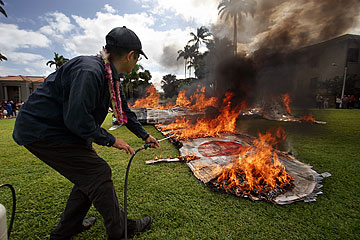AN INCENDIARY STATEMENT
The 'Niihau Zero' goes down in flames
An isle artist re-enacts a WWII crash as part of his series of art projects
Sixty-five years ago yesterday, the last Japanese casualties of the attack on Pearl Harbor lost their lives.
Imperial Navy Zero pilot officer Shigenori Nishikaichi had landed on the isolated island of Niihau after the attack and -- desperate to destroy his airplane and keep the top-secret weapon out of the hands of the Americans -- enlisted the help of two local Japanese Americans to threaten their Hawaiian neighbors.
The plane was burned. And Nishikaichi and his Japanese American ally Yoshio Harada were killed after shooting Hawaiian cowboy Ben Kanahele, who was later decorated by the military government.
Yesterday, the "Niihau Zero" burned again. Artist Katsushige Nakahashi, who created a life-sized mock-up of the airplane flown by Nishikaichi out of a model kit, 25,000 snapshots and miles of tape, chose Dec. 13 as the date of the artwork's auto-de-fe because that is when Nishikaichi died. All of Nakahashi's previous Zero projects were similarly tied in with historic dates and locations, and all were burned as well. The immolation has become part of the artistic process, Nakahashi said.



PHOTOS BY DENNIS ODA / DODA@STARBULLETIN.COM
Katsushige Nakahashi led volunteers, at left, while carrying his life-sized model of a Japanese Zero airplane around the UH-Manoa campus yesterday from the art gallery to a site where an actual bomb shelter once was during World War II, in front of Hawaii Hall. Nakahashi then set fire to the piece, middle, and watched the flames engulf the model. After the flames died down, at right, only ashes and a blackened shadow on the grass was left. (CLICK PHOTOS FOR LARGE VERSIONS)
|
|
Nakahashi and supporters paraded the floppy fighter out of the University of Hawaii Art Gallery, rolling up the wings to get around corners, and took it on a march around campus, making a swing around the peace monument near Kennedy Theatre. With many legs centipeding underneath, it "flew" a couple of circuits of Varney Circle and came to rest on the grass in front of Hawaii Hall.
Nakahashi lit the photographs with a propane torch. A fire truck stood ready nearby. On Monday, there had been a brief outcry from the State Health Department on the possible toxic effects of burning photographs and plastic tape, but Nakahashi provided the necessary environmental reports: The photographs and tape were purposely made of expensive but nontoxic materials. The show could go on.
The paper airplane flared, then flamed, and in a few minutes was a pile of smoldering ash. A perfect silhouette of a Japanese Zero was burned into the grass.
Nakahashi shook the hands of the departing firemen, who elicited the only applause from the couple of hundred onlookers.
The artist stood in the smoke and watched the embers dance in the wind. "Amazing," Nakahashi said, shaking his head. "In Hawaii, it burned faster and burned hotter than anyplace else in the world."
The spirit of pilot officer Nishikaichi?
"I think so."

